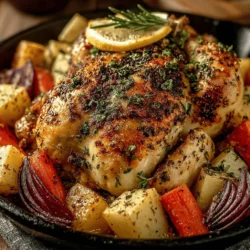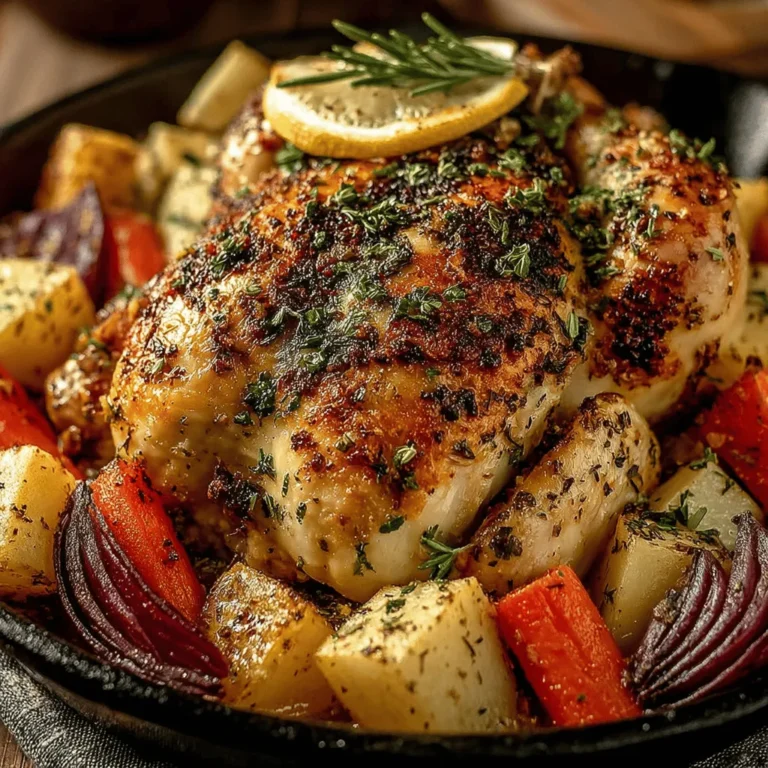Harvest Harmony Roast Chicken: A Comforting Fall Recipe for Every Occasion
Introduction
As the leaves turn to vibrant hues of amber and gold, the culinary world embraces the comforting flavors of fall. Among the season’s offerings, few dishes can rival the warmth and satisfaction of a perfectly roasted chicken. The Harvest Harmony Roast Chicken stands out as a quintessential autumn dish, combining succulent meat with a colorful array of root vegetables and a fragrant herb-infused marinade. This recipe not only serves as a hearty centerpiece for family gatherings and festive occasions but also brings the cozy ambiance of autumn into your kitchen.
The Harvest Harmony Roast Chicken is designed to elevate your dining experience while remaining approachable for home cooks of all skill levels. With its simple yet delightful combination of ingredients, you can create a dish that is as pleasing to the eye as it is to the palate. This article will take you through the essential steps to prepare this comforting roast chicken, ensuring that you achieve juicy meat, crispy skin, and an enticing aroma that fills your home.
Understanding the Ingredients
To create the perfect Harvest Harmony Roast Chicken, understanding the role of each ingredient is crucial. Let’s delve into what makes this dish special.
The Whole Chicken: Choosing the Right Size and Quality
When selecting the star of your dish—the chicken—opt for a high-quality, fresh whole chicken. A size between 3.5 to 4.5 pounds is ideal for roasting, as it provides enough meat to serve a family while still fitting comfortably in your roasting pan. Look for chickens that are free-range or organic, as these options often yield more flavorful and tender meat. Additionally, ensure the chicken is properly stored and has a clean, fresh aroma, which is indicative of its quality.
The Marinade: The Role of Olive Oil, Dijon Mustard, and Fresh Herbs
The marinade is where the magic begins. A mix of olive oil and Dijon mustard serves as the base, providing moisture and flavor. Olive oil not only helps to crisp the skin during roasting but also carries the flavors of the herbs and spices you choose to incorporate. Dijon mustard adds a zesty kick, enhancing the overall taste of the chicken while helping to create a golden-brown crust.
Fresh herbs are crucial to the marinade, and the combination of thyme, rosemary, and parsley is particularly harmonious. These herbs not only complement the rich flavor of the chicken but also add an aromatic quality that is quintessentially autumnal.
Seasonal Vegetables: Benefits of Carrots, Parsnips, Sweet Potatoes, and Red Onions
No roast chicken is complete without a selection of seasonal vegetables. The Harvest Harmony Roast Chicken features a vibrant medley of root vegetables—carrots, parsnips, sweet potatoes, and red onions—that not only enhance the dish’s visual appeal but also contribute to its flavor profile.
Carrots and parsnips provide a natural sweetness that caramelizes beautifully in the oven. Sweet potatoes add a creamy texture and earthy flavor, while red onions lend a slight tang. Together, these vegetables create a colorful and nutritious side that complements the roast chicken perfectly.
The Zesty Touch: How Lemon Enhances Flavor and Moisture
Adding lemon to your marinade and stuffing the chicken cavity with lemon halves serves multiple purposes. The acidity of lemon brightens the flavors of the chicken and the vegetables while also helping to tenderize the meat. As the chicken roasts, the lemon releases its juices, keeping the meat moist and infusing it with a refreshing citrus note that balances the richness of the dish.
Chicken Broth: The Importance of Using Low-Sodium for Balanced Taste
Using low-sodium chicken broth is essential for maintaining a balanced flavor in your dish. This broth not only serves as a base for the roasting process but also ensures that the vegetables cook evenly and absorb the rich flavors from the chicken. Opting for a low-sodium version allows you to control the saltiness of the dish, ensuring that the natural flavors of the chicken and vegetables shine through.
Preparation Steps for Success
Now that we’ve explored the essential components of the Harvest Harmony Roast Chicken, it’s time to dive into the preparation steps. These essential techniques will help you achieve the best results.
Preheating the Oven: Setting the Stage for Perfectly Roasted Chicken
Before you begin preparing your chicken, preheat your oven to 425°F (220°C). This high temperature is crucial for achieving crispy skin while keeping the meat juicy. A well-preheated oven ensures that the chicken starts cooking evenly from the moment it goes in, allowing for optimal roasting conditions.
Preparing the Chicken: Techniques for Achieving Crispy Skin
To ensure crispy skin, it’s important to start with a dry chicken. Pat the chicken dry with paper towels to remove any excess moisture. This step is vital, as moisture on the surface of the chicken can prevent it from browning properly. Next, truss the chicken if desired; this involves tying the legs together with kitchen twine to promote even cooking.
Creating the Marinade: Blending Flavors for Maximum Impact
In a mixing bowl, combine the olive oil, Dijon mustard, minced garlic, and freshly chopped herbs. Whisk these ingredients together until well-blended. This marinade is where the flavors come together, so be sure to taste and adjust the seasoning as needed. You can add a pinch of salt and pepper at this stage, but remember that you will also be seasoning the vegetables and using broth later.
Seasoning the Chicken: Tips for Ensuring Even Flavor Distribution
Generously rub the marinade all over the chicken, making sure to get under the skin and in the cavity for maximum flavor infusion. Consider using a spoon or your hands to work the marinade into every crevice. The goal is to ensure that every bite of meat is flavorful and aromatic. After seasoning, stuff the cavity of the chicken with lemon halves and a few sprigs of any leftover herbs for an extra flavor boost.
Preparing the Vegetables: How to Cut and Coat for Optimal Roasting
While the chicken marinates, it’s time to prepare the vegetables. Peel and chop the carrots, parsnips, and sweet potatoes into uniform pieces to ensure even cooking. Cut the red onions into wedges. In a large bowl, toss the chopped vegetables with olive oil, salt, pepper, and any remaining herbs. This coating not only enhances the flavor but also promotes caramelization during roasting.
With the chicken and vegetables prepared, you are now ready to move on to the roasting process, where the magic truly happens. In the next section, we will discuss the timing and techniques necessary to achieve a perfectly roasted Harvest Harmony Roast Chicken, ensuring a meal that will become a beloved tradition in your autumn repertoire.
{{image_2}}
Navigating the Cooking Process for Flawless Results
Arranging the Roasting Pan: The Importance of a Proper Setup
To achieve the perfect roast chicken, the arrangement of your roasting pan is crucial. Begin by choosing a pan that is large enough to accommodate the chicken and the accompanying vegetables without overcrowding. Ideally, a heavy-duty roasting pan with low sides will allow for even air circulation, promoting a crispy skin.
Place a rack in the pan if you have one; this elevates the chicken, allowing fat to drip away and the heat to circulate all around. If you don’t have a rack, you can create a makeshift rack using chopped vegetables such as carrots or celery. This not only elevates the chicken but also infuses the meat with additional flavor as it roasts.
The Art of Roasting: Understanding Cooking Times and Temperatures
Proper roasting requires understanding both time and temperature. Preheat your oven to 425°F (220°C). This high temperature is essential for achieving that golden-brown skin while ensuring juicy meat. As a general guideline, roast the chicken for about 20 minutes per pound. For a standard 4-5 pound chicken, this translates to approximately 1 hour and 20 minutes to 1 hour and 40 minutes of cooking time.
To help ensure even cooking, it’s wise to rotate the chicken halfway through roasting. This will help to brown all sides evenly. Additionally, you can reduce the heat to 375°F (190°C) after the first 30 minutes if you notice the skin browning too quickly.
Basting the Chicken: Enhancing Flavor and Moisture Throughout Cooking
Basting is a technique that enhances both flavor and moisture in your roast chicken. To baste, use a spoon or a baster to drizzle the pan juices over the chicken every 20-30 minutes. This not only adds flavor but helps to keep the meat moist. If you created an herb-infused butter or oil, use it for basting to further enhance the chicken’s flavor profile.
Consider adding a splash of white wine or chicken broth to the bottom of the roasting pan before placing it in the oven. This will create steam, which can help to keep the chicken moist throughout the cooking process.
Checking for Doneness: How to Ensure Your Chicken is Fully Cooked
To guarantee that your roast chicken is fully cooked, it’s crucial to check for doneness using a meat thermometer. Insert the thermometer into the thickest part of the chicken thigh, avoiding the bone; the internal temperature should reach 165°F (74°C). If you don’t have a thermometer, you can cut into the thigh and observe the juices. They should run clear, not pink, indicating that the chicken is cooked through.
Once your chicken has reached the proper temperature, remove it from the oven and let it rest before carving.
Resting and Serving the Roast Chicken
The Final Steps for a Show-Stopping Presentation
The Importance of Resting: Why Allowing the Chicken to Rest Matters
Resting your chicken after roasting is a crucial step that should not be overlooked. Allow the chicken to rest for at least 15-20 minutes before carving. This resting period lets the juices redistribute throughout the meat, ensuring that every bite is moist and flavorful. Cover the chicken loosely with aluminum foil to keep it warm while it rests.
Carving Techniques: How to Carve Your Chicken Like a Pro
Once your chicken has rested, it’s time to carve. Begin by placing the chicken breast side up on a cutting board. Using a sharp knife, cut through the skin along the breastbone, then carefully slice downwards to separate the breast meat from the bone. Repeat this on the other side.
For the leg quarters, find the joint that connects the thighs to the body and cut through it to separate. Carve the drumsticks from the thighs, and arrange all the pieces artfully on a platter. This not only showcases your culinary skills but also enhances presentation.
Serving Suggestions: Plating the Chicken with Roasted Vegetables
When it comes to serving your Harvest Harmony Roast Chicken, presentation is key. Consider placing the carved chicken pieces on a large serving platter surrounded by the roasted vegetables. The vibrant colors of the carrots, parsnips, and sweet potatoes will add a beautiful contrast to the golden-brown chicken.
For an elegant touch, arrange the vegetables in a way that they cradle the chicken pieces. This not only makes for a stunning presentation but also encourages your guests to enjoy the meal family-style.
Garnishing Ideas: Using Fresh Herbs to Elevate Your Dish
To elevate the visual appeal and flavor of your dish, garnish with fresh herbs. Chopped parsley, thyme, or even sage can add a pop of color and freshness. A sprinkle of these herbs just before serving will enhance the dish’s aroma and make it even more inviting.
Consider also adding a few lemon wedges or slices around the platter for a touch of brightness and to offer guests a refreshing squeeze of citrus over their servings.
Nutritional Benefits of the Harvest Harmony Roast Chicken
Understanding the Health Aspects of Ingredients
Lean Protein: The Nutritional Value of Chicken
Chicken is an excellent source of lean protein, making it a staple in many healthy diets. A 3-ounce serving of roasted chicken breast provides about 25 grams of protein, which is essential for muscle growth and repair. Additionally, chicken is low in saturated fat, particularly when skinless, making it a heart-healthy option.
Nutrient Profiles of Root Vegetables: Carrots, Parsnips, and Sweet Potatoes
The root vegetables in this recipe—carrots, parsnips, and sweet potatoes—are not only delicious but also packed with nutrients. Carrots are high in beta-carotene, which is beneficial for eye health, while parsnips provide a good source of fiber and vitamin C. Sweet potatoes are rich in antioxidants and contain significant amounts of vitamins A and C as well.
Together, these vegetables contribute a variety of vitamins and minerals, making the Harvest Harmony Roast Chicken not only a flavorful dish but also a nutritious one.
The Role of Fresh Herbs: Benefits Beyond Flavor
Fresh herbs are a powerhouse in any dish, offering more than just flavor. Herbs such as rosemary, thyme, and sage are rich in antioxidants and anti-inflammatory properties. They can aid digestion and boost the immune system. Adding these herbs not only enhances the flavor profile of your roast chicken but also contributes to a healthier meal.
Conclusion
The Harvest Harmony Roast Chicken is more than just a recipe; it is an invitation to savor the flavors of the season and create cherished memories around the dinner table. By following the detailed steps outlined in this article, you can master the art of roasting chicken while enjoying the rich tastes of autumn. This dish promises not only to satisfy your hunger but also to nourish your spirit, making it a timeless addition to your culinary repertoire.
Invite your family and friends to gather around, enjoy the warmth of your kitchen, and share in the joy of a beautifully roasted chicken that captures the essence of the harvest season. Whether it’s a weeknight dinner or a festive occasion, this roast chicken will undoubtedly impress and delight all who partake in the feast.


